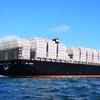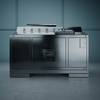Great Ships of 2014: M/V Harvest Leader - ECO Class PCTC
Harvest Leader is an ECO CLASS 7700 units PCTC, built at Hyundai Mipo Dock (HMD) and delivered in October 2014 with a CLEAN class notation. The efficient Post Panamax design was achieved via close collaboration of the owner, the builder and class, in this case DNV GL. The most significant improvement is in the field of energy efficiency in terms of fuel consumption per unit carried, which the owner claims is presently the lowest in the PCTC market. It stands at 5.95 kg MDO per day per unit carried at 20 knots, a reduction of over 30% compared with previous designs. This was achieved in two ways: widening the ship provided a better stability which enabled raising the cargo hold by one additional deck. Both raised the number of units carried; and a new green electronic MAN 7G60 MEC main engine combined with a large propeller diameter at slow RPM enhanced the propulsion efficiency.
Additional contributors to the economics of the ship are: Optimized hull lines; a Promas system; High load tuning of the main engine; High efficiency turbo chargers; Special anti-fouling paint reducing drag; Fuel oil shifter to diminish dependence on oil fired boiler for steam production; Frequency controllers saving electrical energy on steering gear motors, sea water cooling pumps, air conditioning units, and engine room ventilation fans; as well as LED lights for reducing electrical consumption and enhancing luminosity.
Additional “Green Design” details are:
• The ship’ flare angles (Kanerwa formula) are designed to minimize slamming impact and afford good sea keeping together with a slanted bow shape, both reduce wind and weather resistance.
• Strict environmental regulation is enforced by installing low energy consumption Alfa Laval Pure Ballast mark 3.0. Moreover, the ship is prepared in space and design for scrubber installation to meet future SOX regulation.
• An oily water separator is installed with down to 5ppm, and it is equipped with fat separators and plastic shredder to reduce the volume of waste. All fuel and oil tanks, even the smallest ones, are kept away from ship’s shell to avoid the slightest risk for pollution due damage.
Noise reduction levels are in accordance with latest IMO rules. All electrical cables on board are halogen free which are smokeless in case of fire, avoiding toxic gases. The CO2 fire extinguishing lines are connected to sea water as an option for smothering. Twin ECDIS equipped with the latest collision avoidance feature for the OOW. An ECDIS unit is installed in the engine control room for the engine team to be aware of where and what is expected during ship’s maneuvers.
The ship is fully automated, with about 1,500 I/O monitoring and control points, including ship’s stability, automatic anti heeling, trip optimization tool, lighting and fans all controlled from a keyboards.
(As published in the December 2014 edition of Maritime Reporter & Engineering News - http://magazines.marinelink.com/Magazines/MaritimeReporter)















